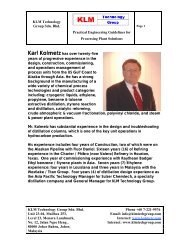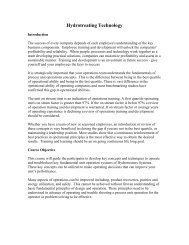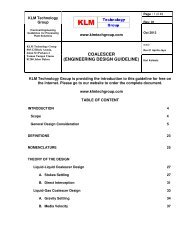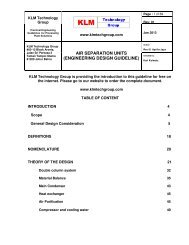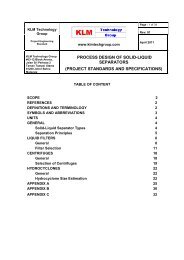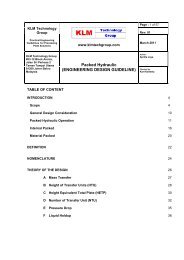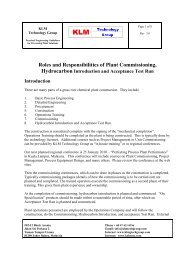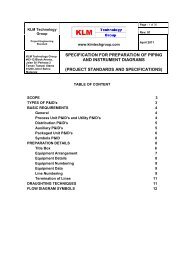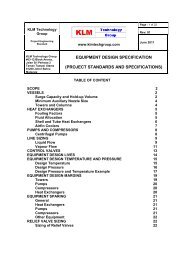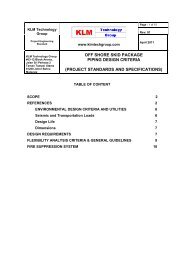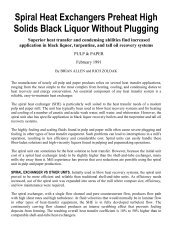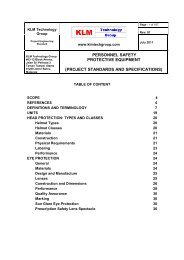SAFETY in OVERPRESSURE RELIEVING SYSTEMS - KLM ...
SAFETY in OVERPRESSURE RELIEVING SYSTEMS - KLM ...
SAFETY in OVERPRESSURE RELIEVING SYSTEMS - KLM ...
- No tags were found...
Create successful ePaper yourself
Turn your PDF publications into a flip-book with our unique Google optimized e-Paper software.
<strong>KLM</strong> TechnologyGroupPractical Eng<strong>in</strong>eer<strong>in</strong>g Guidel<strong>in</strong>esfor Process<strong>in</strong>g Plant Solutions<strong>SAFETY</strong> <strong>in</strong> <strong>OVERPRESSURE</strong><strong>RELIEVING</strong> <strong>SYSTEMS</strong>ENGINEERING DESIGN GUIDELINESPage 8 of 64Rev: 01October 2011The claimed SIL is limited by the calculated Probability of Failure on Demand (PFD) andRisk Reduction Factor (RRF). When the hazards identification and risk assessmentphase concludes that a SIS is required, the level of risk reduction afforded by the SISand the target SIL have to be assigned.Various methodologies are used for assignment of target SILs. The determ<strong>in</strong>ation must<strong>in</strong>volve people with the relevant expertise and experience. Methodologies used fordeterm<strong>in</strong><strong>in</strong>g SIL <strong>in</strong>clude Simplified Calculations, Fault Tree Analysis, Layer of ProtectionAnalysis (LOPA) and Markov Analysis.There are several problems <strong>in</strong>herent <strong>in</strong> the use of Safety Integrity Levels. These can besummarized as follows.Poor harmonization of def<strong>in</strong>ition across the different standards bodies whichutilize SILProcess-oriented metrics for derivation of SILEstimation of SIL based on reliability estimatesSystem complexity, particularly <strong>in</strong> software systems, mak<strong>in</strong>g SIL estimationdifficult to impossibleTable 1: SIL Level and Related MeasureSIL Availability Range ofAverage PFD4321>99.99%99.9%99 to 99.9%90 to 99%10 -5 to 10 -4Range of RRF100,000 to10,00010 -4 to 10 -3 10,000 to 1,00010 -3 to 10 -2 1,000 to 10010 -2 to 10 -1 100 to 10Qualitative ConsequencePotential for fatalities <strong>in</strong> the communityPotential for multiple on-site fatalitiesPotential for major on-site <strong>in</strong>juries or a fatalityPotential for m<strong>in</strong>or on-site <strong>in</strong>juriesSIL 1In a simple <strong>in</strong>dependent SIL 1 SIF (figure 2a), a s<strong>in</strong>gle sensor is used to detect thepressure. The logic solver de-energizes a solenoid operated valve (SOV) remov<strong>in</strong>g airfrom the valve actuator, allow<strong>in</strong>g the valve to go to its specified failed closed (FC)position. A higher reliability (low spurious trip rate) SIL 1 design (Figure 2b) byimplement<strong>in</strong>g 2oo2 vot<strong>in</strong>g for the sensor and SOV. 2oo2 vot<strong>in</strong>g SOVs have beenThese design guidel<strong>in</strong>e are believed to be as accurate as possible, but are very general and not for specific design cases.They were designed for eng<strong>in</strong>eers to do prelim<strong>in</strong>ary designs and process specification sheets. The f<strong>in</strong>al design mustalways be guaranteed for the service selected by the manufactur<strong>in</strong>g vendor, but these guidel<strong>in</strong>es will greatly reduce theamount of up front eng<strong>in</strong>eer<strong>in</strong>g hours that are required to develop the f<strong>in</strong>al design. The guidel<strong>in</strong>es are a tra<strong>in</strong><strong>in</strong>g tool foryoung eng<strong>in</strong>eers or a resource for eng<strong>in</strong>eers with experience.This document is entrusted to the recipient personally, but the copyright rema<strong>in</strong>s with us. It must not be copied,reproduced or <strong>in</strong> any way communicated or made accessible to third parties without our written consent.



